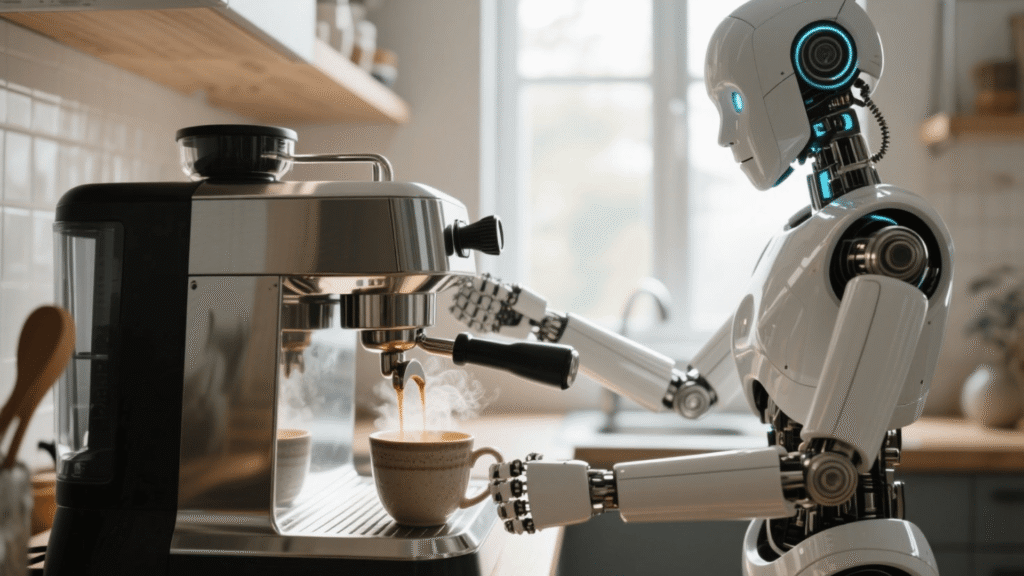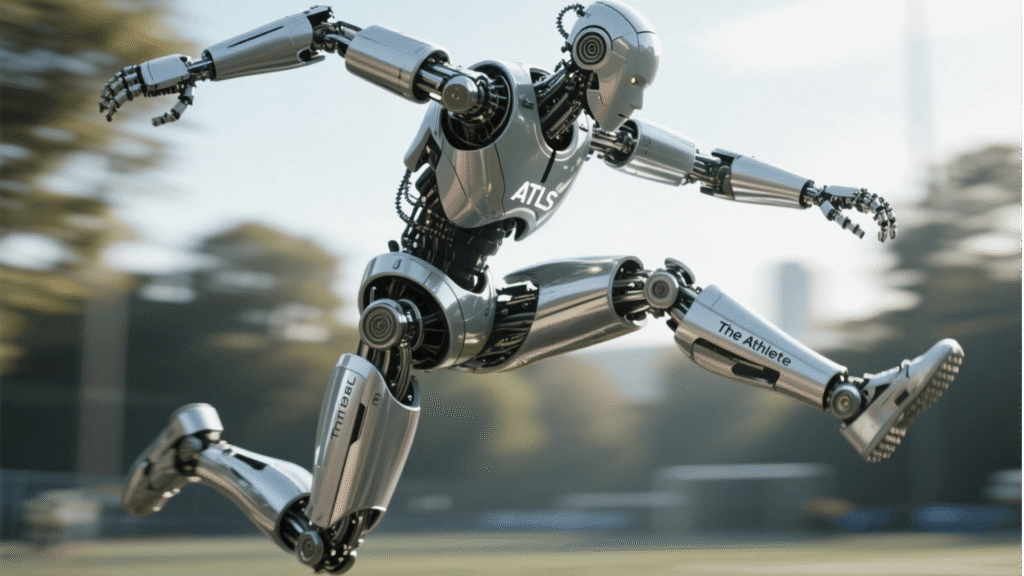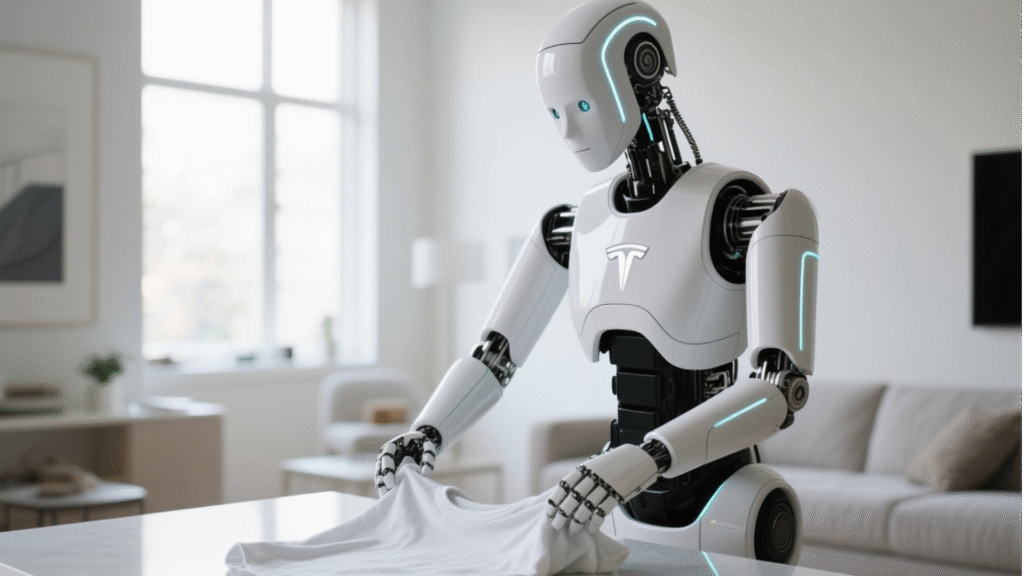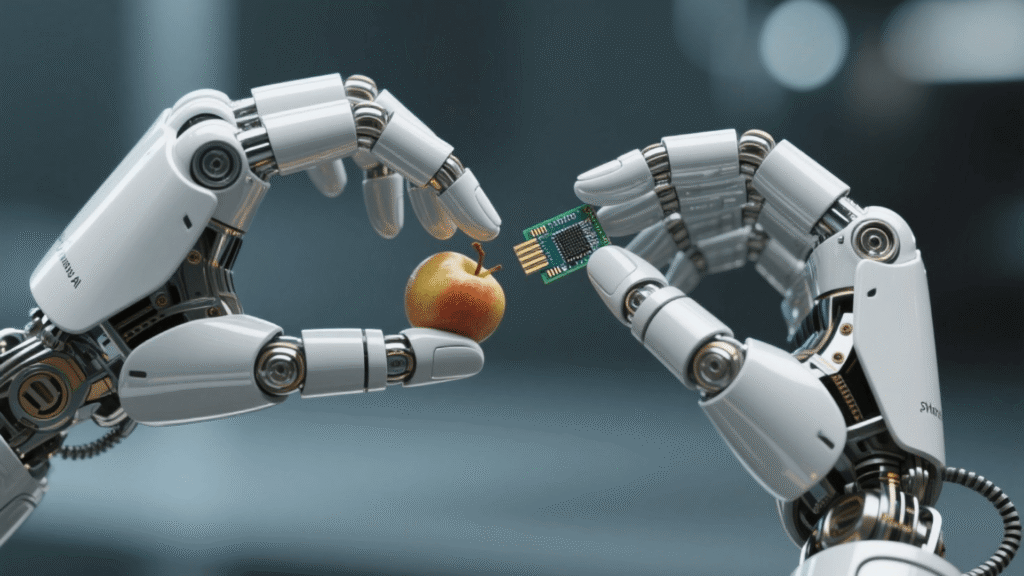Humanoid Robots 2025: Your Ultimate Guide to Embodied AI
Humanoid robots are no longer a viral demo — in 2025 they’re becoming practical machines powered by embodied AI. You’ve probably seen robots strutting through construction sites or making coffee; that’s the real moment we’re living. But hang on, haven’t we had “robots” for ages already? What’s so special now?
TL;DR: The 3 Key Takeaways
- It’s a “Brain in a Body”: Embodied AI combines advanced AI models (like ChatGPT) with physical humanoid robots, allowing them to perceive, reason, and act in the real world.
- The “iPhone Moment” is Here: A perfect storm of powerful AI, realistic simulations (using tech like OpenUSD), and viable hardware is making humanoid robots a reality now, not in 20 years.
- The Race is On: Companies like Figure AI, Boston Dynamics, and Tesla are leading the charge, initially targeting logistics and manufacturing jobs, with the long-term goal of entering our homes.
Here’s the kicker: These new bots aren’t just your grandpa’s factory arms, blindly cranking away in a cage. The real revolution isn’t the hardware—it’s the “mind.” Let’s talk Embodied AI. It’s what happens when you take a wicked smart AI and slap it into a physical body. Suddenly, you’ve got AI that doesn’t just think but actually does stuff in the real world.
Oh, and get this: Figure AI even teamed up with OpenAI for some next-level stuff (check out the official news here). That’s not just hype, it’s a legit turning point. Stick with me. I’ll break all this down—no jargon, just the straight goods.
Before we dive deep, the official OpenUSD channel breaks down in under 3 minutes why this tech is such a big deal. Watch this quick primer, and right after, we’ll get into the full analysis with real-world examples for creators and businesses.
Fonte: AI Revolution
What Is Embodied AI? How Humanoid Robots Work (Explained)
Okay, picture this: old-school AI like ChatGPT is basically stuck in a padded cell—it can write you a haiku about flowers, but ask it to water your plants and it’s useless. Embodied AI? That’s when you let that “mind” out of the box, bolt on some sensors, arms, and legs, and suddenly it’s moving around, seeing, touching, doing stuff.
Here’s the secret sauce—four main ingredients:
The Brain (Foundation Models)
Everything starts with a big ol’ language model. These things can reason, understand language, and break down tasks. Tell it, “Hey, grab me an apple,” and it figures out: find the apple, reach out, pick it up, don’t squish it. Solid.
The Senses (Computer Vision & Sensors)
Eyes and nerves for the robot. Cameras and depth sensors are how it actually sees the world in 3D, recognizes your coffee cup, and knows not to Hulk-smash your eggs. This real-time analysis is made possible by on-device Edge AI.
The Body (Advanced Hardware)
Now we’re talking the actual machinery—electric motors for muscles, batteries that don’t die after ten minutes, and hands that are getting freakishly good at fine movement.
The Soul (How They Learn)
This is where it gets a little trippy. Robots learn in two main ways: First, they grind away for millions of hours in super-realistic video game worlds (Sim-to-Real). Second, they watch humans do stuff—like making coffee—over and over, then practice until they can do it too. Monkey see, robot do.
Why Humanoid Robots Matter Now — The “iPhone Moment” for Robotics
So, why is everyone losing their minds about humanoid robots right now? It’s not one breakthrough. It’s a whole bunch of tech—AI brains, sensors, batteries, beefy GPUs—all finally clicking together. Suddenly robots aren’t just a sci-fi fever dream—they’re about to get real, fast.
1. AI Brains Finally Got Their Act Together
You know that whole ChatGPT craze? Yeah, that was the spark. Suddenly, robots got brains that could actually reason, not just follow scripts like confused Roombas. It’s like someone finally installed a working OS in their heads.
2. Simulations Stopped Sucking
Honestly, training robots in the real world is slow and expensive. The real hack? Platforms like NVIDIA Isaac Sim, built on cool new standards like OpenUSD. Now you can run a million robot lifetimes in a digital twin without anyone losing a finger.
3. Hardware Stopped Being a Joke
Let’s be real—five years ago, robot bodies were either too weak, too clunky, or just plain broke. That’s changed, big time. The cash is pouring in, too. Take Figure AI’s monster $675 million funding round—you’ve got Bezos, Microsoft, the works. Suddenly, building a robot that doesn’t fall over isn’t science fiction.
Key Takeaway
The rise of humanoid robots isn’t due to one invention, but the convergence of three key areas: powerful AI brains for reasoning, hyper-realistic simulations for safe training, and viable hardware components becoming cheaper and more efficient.
Who’s Building Humanoid Robots? The Key Players
Time to meet the cast:
Figure AI (The Workhorse)
These folks are teaming up with OpenAI (for the brains) and BMW (for the first gig on the assembly line). Hype is real. (See Figure 01 doing its thing here.)

Boston Dynamics (The Athlete)
The OGs. Atlas is basically a gymnast in robot form. Owned by Hyundai now, because, why not? (Prepare to have your mind blown by Atlas here.)

Tesla (Optimus)
Yeah, it’s the Elon show. He’s betting on his car AI smarts and factories to crank out robots for the masses. (Catch Optimus in all its glory here.)

Sanctuary AI (Phoenix)
All about brains and hands. They want general intelligence and robot hands that can actually pick stuff up, not just fumble around. (Check out Phoenix flexing its skills here.)

What Humanoid Robots Will Actually Do (Short, Mid & Long Term)
- Short-Term (1-3 Years): The “nobody wants to do it” jobs. Moving boxes, loading pallets, working in warehouses—basically, the boring and back-breaking stuff.
- Mid-Term (3-7 Years): Think retail clerks and hospital helpers. Restocking shelves at 2am, shuttling equipment around. Not glamorous, but super useful.
- Long-Term (10+ Years): The Big Dream. Actual home robots that do the laundry, help grandma up the stairs, maybe even make a decent cup of coffee. We’re not there yet, but hey, that’s the holy grail.
Why Aren’t You Ordering a Robot Butler Off Amazon Yet?
Batteries, man. All this fancy AI and nimble hardware means nothing if your robot taps out after 30 minutes. It’s like buying a phone that needs charging after every call. The battery problem is a beast—if you wanna nerd out, read this IEEE Spectrum piece on the energy struggle in robotics.
The “Hand” Problem? Yeah, robots still kinda suck at fine motor skills. Picking up an egg without crushing it? Still like rocket science for most bots.
The Cost Problem? Oof. These things go for the price of a decent house—think hundreds of thousands, not pocket change.
The Safety Problem? Imagine a 150lb robot tripping around your living room. Making sure that’s not a disaster waiting to happen? Not trivial.
The “Creepiness” Factor? Let’s be real, having a human-shaped machine walking around the office is just… weird. Beyond the technical hurdles, there’s a massive social and psychological barrier—the “uncanny valley”—that companies need to overcome for these robots to be truly accepted in our daily lives.
Conclusion: The Next Frontier is Physical
So, bottom line: The next big leap for AI isn’t just smarter chatbots. It’s physical—robots moving out from computer screens into the chaos of real life. This isn’t just sci-fi fodder anymore; it’s straight-up engineering and business sweat. We’re not talking “maybe someday.” We’re talking right now—companies are grinding away at the problems.
Big picture? We’re at the starting line of a race that’s gonna redefine how we work and, honestly, how we even think about getting stuff done. Automation isn’t just a buzzword—it’s about to get real.
And hey, while you can’t exactly pick up a robot roommate at Best Buy yet, digital AI agents are already here. Wanna see what I’m talking about? You can jump in—literally right now—for free. Try out something like AgentGPT and watch the future unfold in your own browser. Go ahead, it’s wild.
FAQ — Humanoid Robots & Embodied AI
Want weekly AI & Robotics briefings?
Subscribe and get a one-page “Robotics 2025 Cheat Sheet” when you join.







